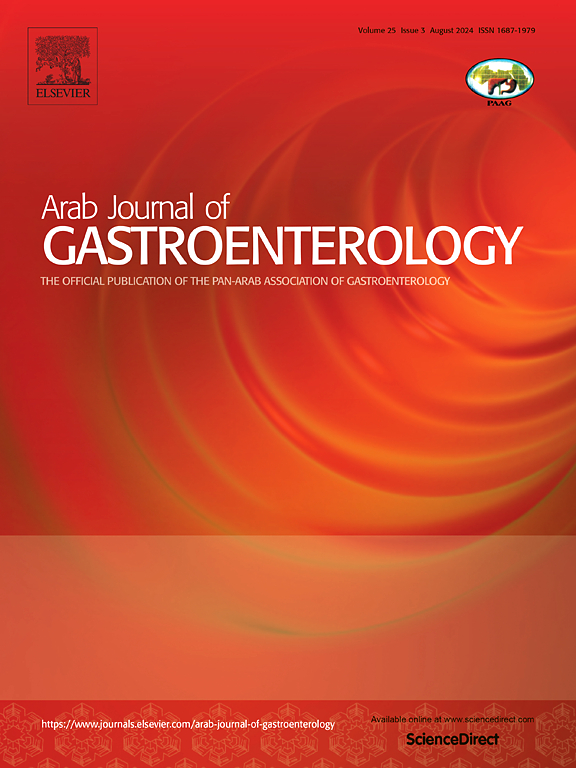Clinical features and temporal trends in H. pylori negative gastric maltoma
IF 1.1
4区 医学
Q4 GASTROENTEROLOGY & HEPATOLOGY
引用次数: 0
Abstract
Background
Mucosa-Associated Lymphoid Tissue (MALT) lymphoma or MALToma is a type of non-Hodgkin lymphoma arising in the gastric mucosa that has largely been associated with Helicobacter pylori (H. pylori) infection. However, less than 10% of gastric MALTomas can occur with a negative H. pylori status, and the disease seems to have a different course.
Patients and methods
Patients diagnosed with MALToma from 2000 to 2021 were included in the study. H. pylori-negative (HPN) status was confirmed when patients had at least 2 negative tests among the following: urea breath test, rapid urease test, serological test, or histology. The patients were divided into H. pylori positive (HPP) and HPN groups.
Results
The final analysis included 52 gastric MALToma patients, 25 (48.1 %) were HPN. Demographics and disease stages were comparable between the two groups, although a higher prevalence of HPN cases emerged in patients diagnosed from 2011 to 2021 compared to the 2000–2010 period (55.3 % vs. 28.6 %, p = 0.09). All patients in the HPP group received eradication therapy (ET) compared to only 40 % in the HPN group. ET success in the stage 1 HPN group was 25 % compared to 78.6 % in the HPP group (p = 0.03). More patients in the HPN group received chemo and/or radiotherapy compared to the HPP (86.4 % vs 57.1 %, p = 0.033). Treatment outcomes were similar between both groups. Comparing stage 1 MALToma patients who responded to ET versus non-responders revealed that responders were more likely to be HPP (76.8 % vs. 33.3 %, p = 0.026) and diagnosed in the earlier period (2000–2010, p = 0.048).
Conclusion
HPN MALToma patients were similar to HPP patients in clinical features. However, there was an increase in diagnosis of HPN MALToma and a decrease in response to ET in more recent years.
幽门螺杆菌阴性胃恶性瘤的临床特征和时间趋势。
背景:粘膜相关淋巴组织(MALT)淋巴瘤或MALToma是一种发生在胃粘膜的非霍奇金淋巴瘤,主要与幽门螺杆菌(h.p ylori)感染有关。然而,只有不到10%的胃MALTomas可以在幽门螺杆菌阴性状态下发生,并且该疾病似乎有不同的病程。患者和方法:2000年至2021年诊断为MALToma的患者纳入研究。当患者在尿素呼气试验、快速脲酶试验、血清学试验或组织学试验中至少有2项阴性时,确认幽门螺杆菌阴性(HPN)状态。将患者分为幽门螺杆菌阳性(HPP)组和HPN组。结果:最终分析胃MALToma患者52例,HPN 25例(48.1%)。两组之间的人口统计学和疾病分期具有可比性,尽管2011年至2021年诊断的患者中HPN病例的患病率高于2000年至2010年期间(55.3%对28.6%,p = 0.09)。HPP组的所有患者都接受了根除治疗(ET),而HPN组只有40%。1期HPN组的ET成功率为25%,而HPP组为78.6% (p = 0.03)。与HPP组相比,HPN组更多的患者接受了化疗和/或放疗(86.4% vs 57.1%, p = 0.033)。两组治疗结果相似。比较对ET有反应的1期MALToma患者和无反应的患者发现,反应者更可能是HPP (76.8% vs 33.3%, p = 0.026)和早期诊断(2000-2010,p = 0.048)。结论:HPN MALToma患者的临床特征与HPP患者相似。然而,近年来,HPN MALToma的诊断有所增加,而对ET的反应有所减少。
本文章由计算机程序翻译,如有差异,请以英文原文为准。
求助全文
约1分钟内获得全文
求助全文
来源期刊

Arab Journal of Gastroenterology
Medicine-Gastroenterology
CiteScore
2.70
自引率
0.00%
发文量
52
期刊介绍:
Arab Journal of Gastroenterology (AJG) publishes different studies related to the digestive system. It aims to be the foremost scientific peer reviewed journal encompassing diverse studies related to the digestive system and its disorders, and serving the Pan-Arab and wider community working on gastrointestinal disorders.
 求助内容:
求助内容: 应助结果提醒方式:
应助结果提醒方式:


